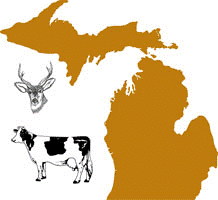Wildlife Disease and Zoonotics

Michigan Bovine Tuberculosis Bibliography and Database
Date of this Version
2009
Abstract
Monitoring of the kinetics of production of serum antibodies to multiple mycobacterial antigens can be useful as a diagnostic tool for the detection of Mycobacterium bovis infection as well as for the characterization of disease progression and the efficacy of intervention strategies in several species. The humoral immune responses to multiple M. bovis antigens by white-tailed deer vaccinated with BCG orally via a lipid-formulated bait (n = 5), orally in liquid form (n = 5), and subcutaneously (n = 6) were evaluated over time after vaccination and after experimental challenge with virulent M. bovis and were compared to the responses by unvaccinated deer (n = 6). Antibody responses were evaluated by using a rapid test (RT), a multiantigen print immunoassay (MAPIA), a lipoarabinomannan enzyme-linked immunosorbent assay (LAM-ELISA), and immunoblotting to whole-cell sonicate and recombinant antigen MPB83. MAPIA and RT detected minimal to no antibody responses over those at the baseline to multiple M. bovis antigens in vaccinated white-tailed deer after challenge. This was in contrast to the presence of more readily detectable antibody responses in nonvaccinated deer with more advanced disease. The LAM-ELISA results indicated an overall decrease in the level of production of detectable antibodies against lipoarabinomannan-enriched mycobacterial antigen in vaccinated animals compared to that in nonvaccinated animals after challenge. Immunoblot data were inconsistent but did suggest the occurrence of unique antibody responses by certain vaccinated groups to Ag85 and HSP70. These findings support further research toward the improvement and potential use of antibody-based assays, such as MAPIA, RT, and LAM-ELISA, as tools for the antemortem assessment of disease progression in white-tailed deer in both experimental and field vaccine trials.


Comments
Published in CLINICAL AND VACCINE IMMUNOLOGY, Mar. 2009, p. 323–329.